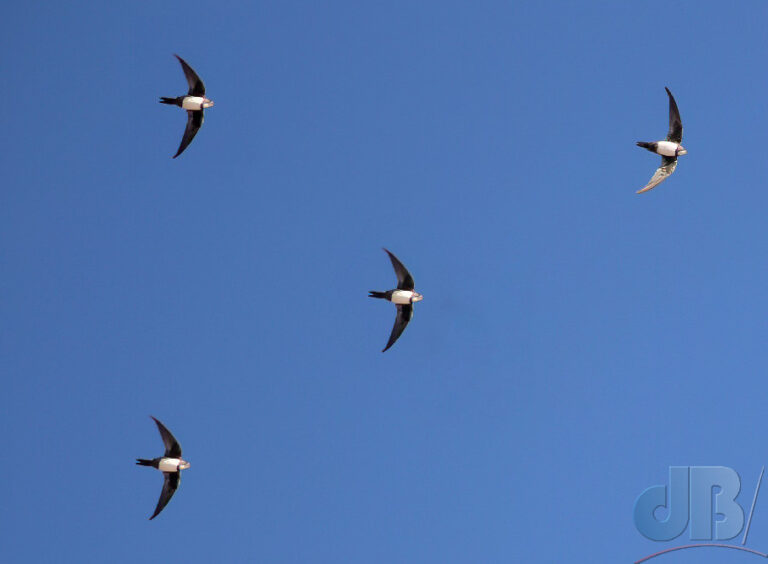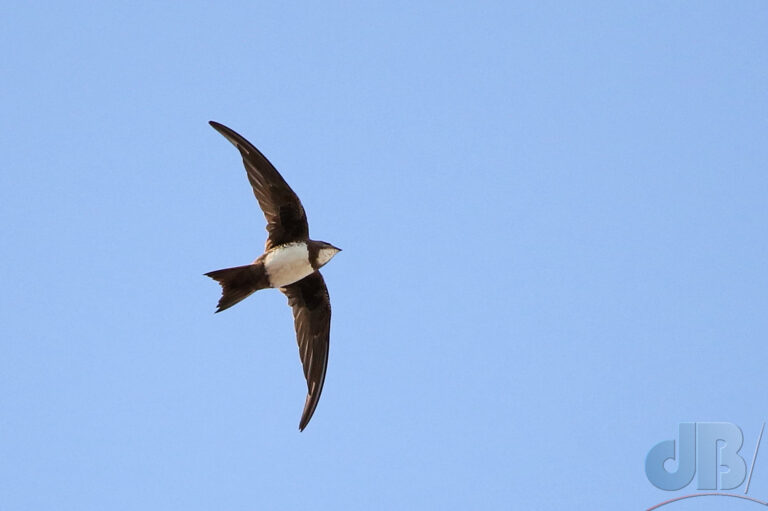TL:DR – The bird report pages noted what seemed to be quite an unusual number of Alpine Swifts across the UK during March 2023.
Back in 2019, we took a trip to Greece, the first in many years, we saw lots of wildlife, including Alpine Swift, Tachymarptis melba, careening way above our heads in Athens.
The alpine swift is a medium-sized bird with a wingspan of around 540-600 mm. It has a dark-brown body with a slightly paler throat and underbelly. In flight, it is easily identified by its long, narrow wings and its distinctive white belly patch, which contrasts sharply with the dark body. It is a skilled and agile flier, capable of catching insects on the wing with great precision. Indeed, it rarely touches down, spending almost its whole life, once fledged on the wing, except perhaps when incubating eggs in their nests. It will only very rarely land on the ground.

During the breeding season, which typically runs from May to August, Alpine Swifts build their nests in crevices and holes in the rocky cliffs and mountainsides of southern Europe to the Himalaya. They use their saliva to glue together small twigs and feathers, forming a shallow, cup-shaped nest. The female lays a clutch of 2-3 eggs, both parents take turns to incubate the eggs for around three weeks.
After the breeding season, the Alpine Swift migrates south to spend the winter in sub-Saharan Africa. They are known for their long-distance flights and are capable of covering up to 1000 km in a 24-hour period. They will return to the same nest sites year after year.
As I was writing this, yet another “ping” came in on my rare bird sightings app to alert me to another Alpine Swift having been spotted in the UK. It’s March 2023. Quite early for the Common Swift, which we always see in the UK each summer. Alpine Swifts though? Very unusual. They have been sighted in numerous places in the UK and Ireland this spring.

Sightings have been reported since mid-March this year in the following counties: Antrim, Armagh, Cheshire, Cork, Cornwall, Devon, Dorset, Down, Dublin, Dumfries & Galloway, East Sussex, Essex, Forth, Glamorgan, Gloucestershire, Isle of Man, Isle of Wight, Kent, Leitrim, Lincolnshire, London, Lothian, Mayo, Norfolk, Northumberland, Pembrokeshire, Somerset, Waterford, Wicklow, Yorkshire.
The early reports were marked as “notable” rather than “mega”. In 2022, there was just one noted in March, although later in the year a few others were sighted. Similarly for previous years. So, while I admit, I’d not known about their habits this far north and west of southern Europe, it does seem that a large number have appeared in British and Irish skies very early in the spring this year.
One cannot make generalisations about animal behaviour based on data from a single year, of course. However, the appearance of Alpine Swifts in numbers, this early in the year, suggests something may have changed for them this period. It could simply be changes in weather patterns and wind currents, whether or not those are due to climate change is a different matter. It is known that Alpine Swifts to range quite widely during their migration so maybe this is not an aberration at all and just a reversion to a pattern they followed some time in the distant past.
Stephen Moss discussed the recent irruption of Alpine Swifts in The Guardian some time after my original post and alluded to the fact that because of climate change, this species may well begin breeding in the UK at some point in the next few years, if it hasn’t already done so.